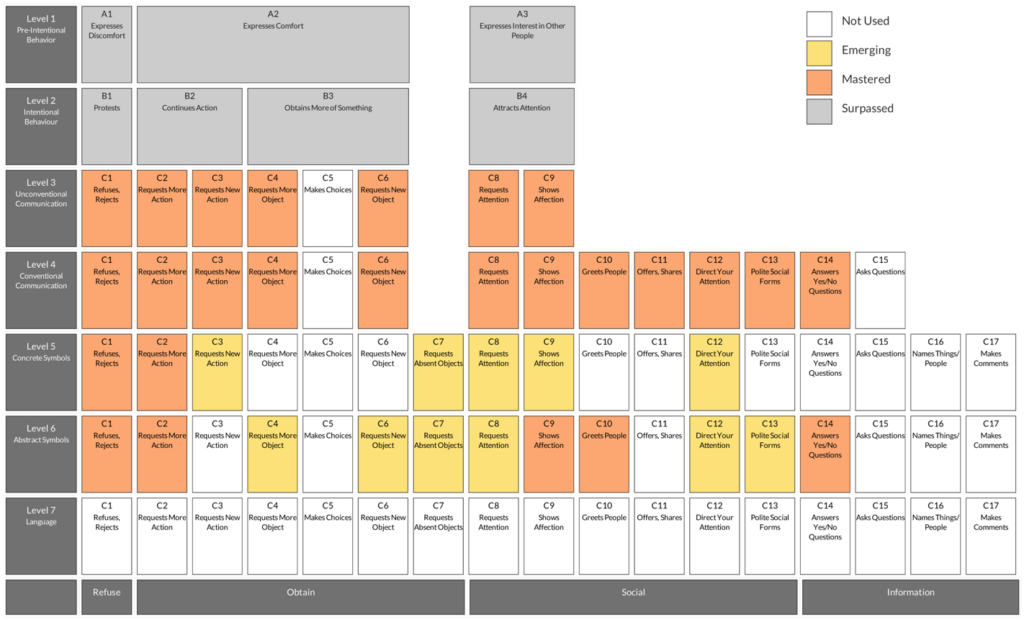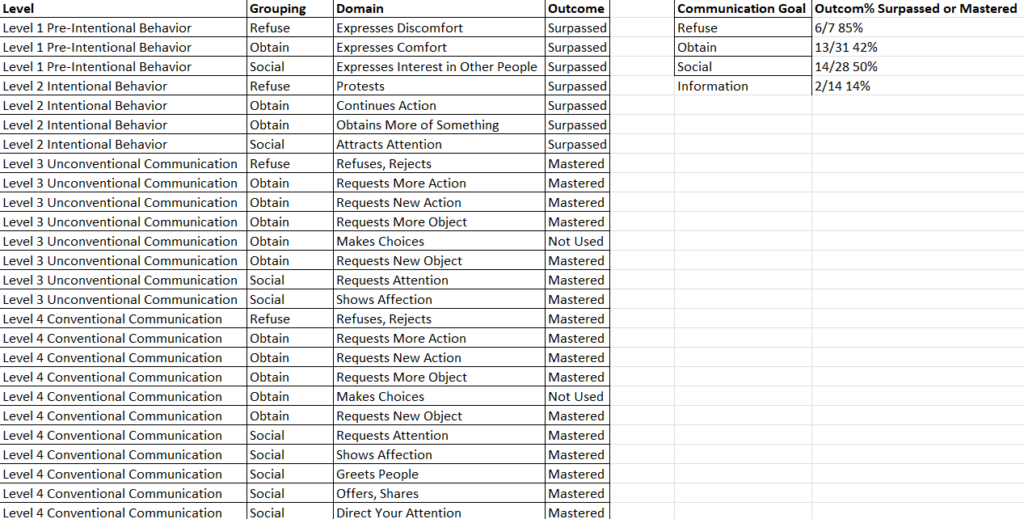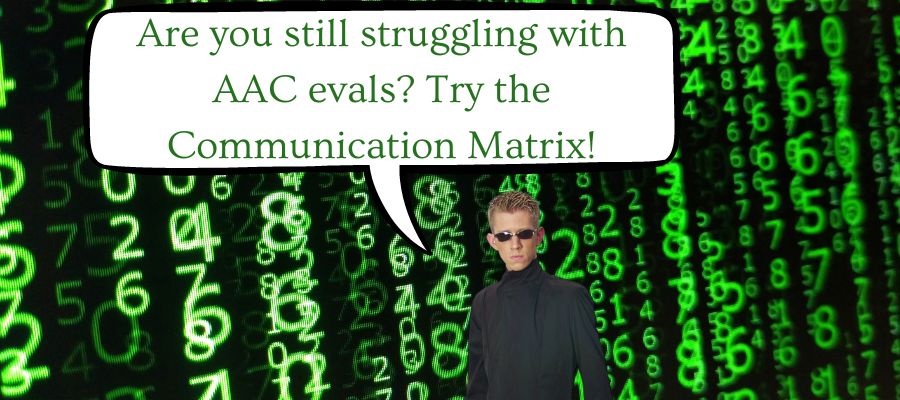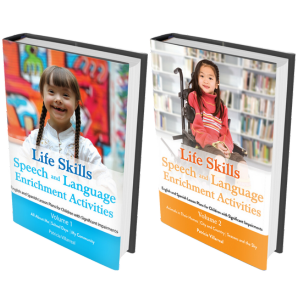Few evaluations can feel more daunting than assessing a child who is not speaking and may be in need of Alternative and Augmentative Communication (AAC) or Assistive Technology (AT) such as an iPad or a picture-symbol system. An assessment tool that I rely on consistently for assessing individuals who are non-verbal is the Communication Matrix. For those of you that don’t know:
The Communication Matrix is an online tool that helps professionals understand the communication needs of anyone functioning at the early stages of communication who is not speaking or writing. The first few administrations are free.
It’s an easy system where you create a profile and combine your data and the insights from parents, teachers, and nurses to create a robust communication profile. This makes it easy to write goals and also write up the evaluation. Let’s first talk about how to use it, then how to conduct a communication matrix assessment and how to write it up.
How to Use the Communication Matrix
For those of you that are unfamiliar with the communication matrix, I want to talk about the process so that you do not feel intimidated. You make an account, log in, and then answer a series of questions that are really specific to the daily functional activities of the student, client, or patient that you’re serving.
I go in and I answer those questions to the best of my ability and then I bring in the teacher, educational assistant and, or even a fine arts teacher. Basically, someone who knows the student really well. The more the better because each person brings additional insights,
Next, the communication matrix makes explaining an evaluation to parents really easy. You let them know that we are looking at the different areas such as pre-intentional behavior, intentional, conventional, and unconventional communication using concrete symbols or abstract symbols, or using verbal language. The communication matrix gives us examples so all those big words don’t sound so scary. Also let them know that you will be walking through them with the questions.
Communication Matrix Example
The beautiful thing about the Communication Matrix is that it immediately creates a nice chart showing all the responses so you can then explain the child’s communication abilities.
It’s basically a map of abilities across different communication areas that is color-coded based on skills that are not used, emerging, mastered, or surpassed. Here’s a communication matrix example and then in the next part I’ll show you how I write it up.

Communication Matrix Template for Reports
I built a communication matrix template for my assessments off of that beautiful, colorful, results page the communication matrix generates. It includes a header paragraph explaining the testing, then text about each area. I count up the skills in each area to see what percentage has been mastered and what is still emerging or in development.
Communication Matrix Report Template Header Text
The Communication Matrix as used to assess CHILD’s language abilities. The Communication Matrix is an assessment tool that is used to determine how a patient is communicating and to provide a framework for determining communication goals in terms of specific behaviors and communicative functions or intents. The assessment is based on caregiver report, clinician observations, and elicited communication.
The Communication Matrix analyzes the patient’s method of communication, which ranges from pre-intentional behaviors to the use of two- and three-symbol utterances, used to express four basic reasons for communicating (refuse, obtain, social interactions, and provide or seek information). It does not provide standard scores or percentiles but provides a series of four matrices representing the four basic reason for communicating and seven levels of competence.
TOTAL SCORE: Mastered or Surpassed 33 Domains (maximum = 85)
PERCENTAGE: 40%
Here are CHILD’s results, followed by an explanation.
Here is an example of the communication matrix assessment chart that I put in each report. It is filled in from the colored table, and how I got my scores above

Communication Matrix Report Template Text
For the write up, again the Communication Matrix makes everything so easy. You simply talk in terms of strengths and weaknesses, in expressive and receptive domains. Here is my exact report text that you can use in your communication matrix report template.
CHILD mastered 40% of the communication abilities expected for a child her age. These strengths include rejecting or refusing objects she does not want or is not interested in, requesting more with gestures or verbalization, showing affection, greeting people, and answering yes/no questions with words and gestures.
CHILD demonstrated emerging skills in 13% of the communication areas tested. These areas represent great areas of focus for intervention because they show some level of ability or understanding and some needed focus to communicate functionally. These include:
- Requesting new actions verbally or by indicating a photo
- Requesting absent object by name, pointing at a picture, or making the sound of the object
- Requesting attention with words
- Identifying pictures or story characters that are demonstrating emotion
- Directing the attention of an adult with a photo or symbol.
She was largely successful at the first 4 levels which included pre-intentional behavior, intentional behavior, unconventional communication, and conventional communication. She demonstrated some mastery and some emerging skills at level 5: concrete symbols, and level 6: abstract symbols. CHILD was unsuccessful undertaking any activity that would be described in level 7 as using words or verbal language.
The Communication Matrix also enables a clinician to group results based on communication goals including: refuse, obtain, social, and information. Viewing CHILD’s results from this perspective, her performance based on communication goals was:
Communication Goal Outcome: % Surpassed or Mastered
- Refuse 6/7 85%
- Obtain 13/31 42%
- Social 14/28 50%
- Information 2/14 14%
CHILD successfully refuses objects or activities or expresses dissatisfaction. She is semi-successful obtaining what she wants at the level of pointing or bringing an adult to an object or task she wants help with. She socializes well, making eye contact, demonstrating humor, and playing together, all at a non-verbal level except for greetings (hola, bye).
She has great difficulty requesting or giving information.
Relative receptive language strengths included:
- Looking at objects or people the caregiver or another person looks at and points to without naming them
- Identifying familiar objects from a group of objects with gestural cues
- Following commands with gestural cues
- Understanding inhibitory words (other than no)
- Engaging in pretend play
- Understanding the verbs comer, tomar/beber, and dormir (eat, drink, sleep) in context
Relative receptive language weaknesses included:
- Identifying photographs of familiar objects
- Understanding pronouns (-me, tu; me your)
- Understanding pronouns (mi, tuya; my yours)
- Recognition of action in pictures
- Following directions without gestural cues
- Understanding the use of objects
Relative expressive language strengths included:
- Participating in a play routine with another person for at least 1 minute while using appropriate eye contact
- Extending toy or pointing to objects to show others
- Using at least five words
- Initiating a turn-taking game or social routine
Relative expressive language weaknesses included:
- Using words for a variety of pragmatic functions
- Using words more often than gestures to communicate
- Naming objects in photographs
- Using different word combinations
Summary and Goals for the Communication Matrix Assessment
Just when you think that this tool couldn’t make our life any easier, writing up goals and recommendations can come right out of the communication matrix assessment! Even if you are going to suggest goals around Total Communication. Basically, we summarize by listing all of the strengths. These are all abilities that are Mastered or Surpassed. Then we write goals around any skills that were emerging and consider any that were: Not Used. Here’s what it looks like.
SUMMARY AND RECOMMENDATIONS:
CHILD is a 4-year, 8-month-old female who was evaluated due concerns in articulation and phonology, receptive language and expressive language.
Results indicate that CHILD qualifies for services because she was below normal limits in the following communication areas: articulation and phonology, receptive language and expressive language. CHILD was within normal limits in the areas of voice, fluency and pragmatic languages
LONG- AND SHORT-TERM GOALS
LTG: CHILD will improve receptive language skills to allow her to understand directives and concepts related to her health and safety, and to support independence in her daily life with a variety of communication partners across environments.
STG: CHILD will identify age-appropriate concepts by pointing to simple objects from a field of 3-5 objects. in 70% of opportunities with moderate support
STG: CHILD will answer age-appropriate ‘yes/no’ questions related to personal experiences/classroom discussions/stories in 70% of opportunities with moderate support
STG: CHILD will identify age-appropriate concepts by pointing to pictures based on size color and number concepts in 70% of opportunities with moderate support
STG: CHILD will identify age-appropriate concepts by pointing to pictures/objects of size concepts in 70% of opportunities with moderate support
LTG: CHILD will improve expressive language skills to allow her to communicate a variety of messages related to her health and safety, and to support independence in her daily life with a variety of communication partners across environments.
STG: CHILD will pair vocalizations with gestures when indicating want or requesting objects in 70% of opportunities with moderate support
STG: CHILD will ask for “more” with words and/or signs in 70% of opportunities with moderate support
STG: CHILD will indicate “finished” with words and/or signs in 70% of opportunities with moderate support
STG: CHILD will ask for “help” using words and/or signs in 70% of opportunities with moderate support
LTG: CHILD will improve speech intelligibility to allow her to communicate a variety of messages related to her health and safety, and to support independence in her daily life with a variety of communication partners across environments.
STG: CHILD will repeat 5 vowels (a,e,i,o,u) with visual support and 70% accuracy.
STG: CHILD will repeat 4 bilabial consonants (p,b,m,w) with visual support and 70% accuracy.
STG: CHILD will repeat 3 interdental consonants (d,t,n) with visual support and 70% accuracy.
And for those of you working in the clinic, a communication matrix assessment also easily provides up with the needed functional implications
FUNCTIONAL IMPLICATIONS: CHILD’s health and safety are impacted in the following ways:
- CHILD is not able to express herself in a way that can be fully understood. This could impact her ability to communicate important information when she is injured or experiences another event that directly impacts her safety and health.
- CHILD is unable to tell past events with sufficient details and in the correct order to facilitate listener understanding.
- CHILD is not able to answer questions that relate to her health and safety.
- CHILD struggles to follow complex instructions, which could increase her risk of harm in an emergency situation.
FUNCTIONAL OUTCOME: CHILD will gain articulation and language skills that allow her to fully participate in her daily activities at home and in the community.
For those of you that were wondering, this report was generated in minutes using Evalubox and the template library we have there. If you are still writing reports by cutting and pasting, do yourself a favor and watch the short videos how-to videos at Evalubox.




